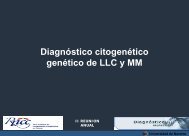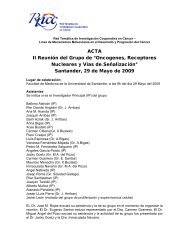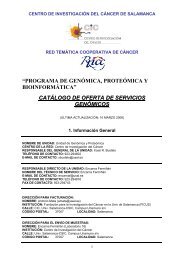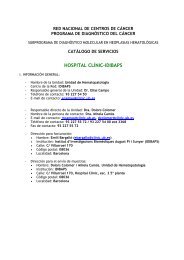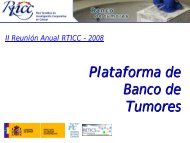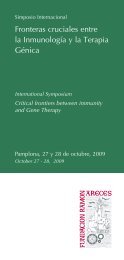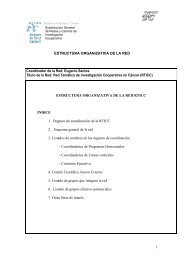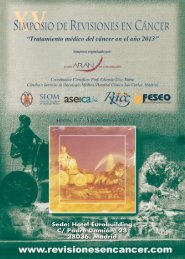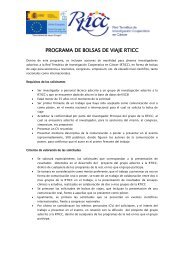Untitled - Red Temática de investigación cooperativa en cáncer
Untitled - Red Temática de investigación cooperativa en cáncer
Untitled - Red Temática de investigación cooperativa en cáncer
Create successful ePaper yourself
Turn your PDF publications into a flip-book with our unique Google optimized e-Paper software.
P-24<br />
NOX4 PLAYS A TUMOR SUPRESSOR ROLE IN HEPATOCELLULAR<br />
CARCINOMA CELLS<br />
Crosas-Molist E 1 , Bertran E 1 , Fernando J 1 , Fabregat I 1, 2<br />
1<br />
IDIBELL, BARCELONA (RD06/0020/0097)<br />
2<br />
UNIVERSIDAD DE BARCELONA, BARCELONA<br />
Introduction and AIMS: NOX4 has be<strong>en</strong> implicated in a variety of physiological processes,<br />
including cellular s<strong>en</strong>esc<strong>en</strong>ce, apoptosis, survival, migration, <strong>en</strong>doplasmic reticulum<br />
stress, and differ<strong>en</strong>tiation (Brown and Gri<strong>en</strong>dling, Free Radic Biol Med. 2009). In liver cells,<br />
NOX4 upregulation is necessary for TGF-beta-induced suppressor effects, in particular, for<br />
cell <strong>de</strong>ath (Carmona-Cu<strong>en</strong>ca et al., J Hepatol. 2008; Caja et al., Cancer Res. 2009). In or<strong>de</strong>r<br />
to analyze whether NOX4 may play a g<strong>en</strong>eral tumor suppressor role in liver tumorig<strong>en</strong>esis,<br />
we have analyzed the effect of NOX4 knock-down in human HCC (hepatocellular carcinoma)<br />
cell lines.<br />
Results: Stable sil<strong>en</strong>cing of NOX4 conferred an increased proliferative capacity to HCC<br />
cell lines, as proved through a DNA synthesis assay and by impedance measurem<strong>en</strong>t of<br />
attached cells through time (Roche xCELLig<strong>en</strong>ce System). Caspase-3 activity assay was performed<br />
in or<strong>de</strong>r to analyze basal cell <strong>de</strong>ath, showing <strong>de</strong>creased apoptosis in sil<strong>en</strong>ced cells<br />
wh<strong>en</strong> compared to control cells. Interestingly,NOX4 sil<strong>en</strong>cing increased migration capacity.<br />
This finding was in accordance to a diminished cell-ECM (Extracellular Matrix) adhesion<br />
capacity, important for individual migration. Cell-to-matrix adhesion was analyzed by impedance<br />
measurem<strong>en</strong>t in differ<strong>en</strong>t substrates such as an inert matrix, collag<strong>en</strong> I, collag<strong>en</strong><br />
IV and fibronectin. Results showed a <strong>de</strong>creased adhesion capacity of the sil<strong>en</strong>ced cells in<br />
all the substrates studied. Moreover, Vinculin and p-FAK immunofluoresc<strong>en</strong>ce showed a<br />
differ<strong>en</strong>t pattern in NOX4 knock-down cells in comparison to control cells. Finally, stable<br />
sil<strong>en</strong>cing of NOX4 increased the tumorig<strong>en</strong>ic capacity of HCC cells after subcutaneous injection<br />
of them into Balb c/Nu<strong>de</strong> mice.<br />
Conclusion: Stable sil<strong>en</strong>cing of NOX4 in HCC cells confer them a more malignant ph<strong>en</strong>otype,<br />
since they show increased cell proliferation and <strong>de</strong>creased basal apoptosis. Simultaneously,<br />
a more invasive ph<strong>en</strong>otype is observed, with <strong>de</strong>creased cell-to-cell contact and<br />
cell-to-matrix attachm<strong>en</strong>t, and increased migration. In summary, NOX4 may play a relevant<br />
tumor suppressor role in liver tumorig<strong>en</strong>esis.<br />
P-25<br />
AhR BINDING TO Alu ELEMENTS X14S, X36S AND X45S MODULATES THE<br />
EXPRESSION OF STEMNESS-RELEVANT GENES Oct4, Nanog, Shh AND Sox2<br />
GONZÁLEZ RICO FJ 1 , ÁNGEL CARLOS ROMÁN 2 , PEDRO M. FERNÁNDEZ SALGUERO 1<br />
1<br />
UNIVERSIDAD DE EXTREMADURA, BADAJOZ (RD06/0020/1016)<br />
2<br />
INSTITUTO CAJAL, CSIC<br />
Eukaryotic g<strong>en</strong>omes are organized into expression domains whose activity <strong>de</strong>p<strong>en</strong>ds on<br />
local chromatin structure. To accomplish that, functional g<strong>en</strong>e clusters are <strong>de</strong>fined by the<br />
binding of transcription factors to conserved regulatory sequ<strong>en</strong>ces. Transposable elem<strong>en</strong>ts<br />
are no longer consi<strong>de</strong>red parasite mobile sequ<strong>en</strong>ces; instead they seem to regulate g<strong>en</strong>e<br />
expression by modulating g<strong>en</strong>ome organization and stability. Such transposon functions are<br />
likely associated to their ability to bind specific transcription factors.<br />
We have previously reported that a g<strong>en</strong>ome-wi<strong>de</strong> SINE-B1 retrotransposon (B1-X35S) has<br />
a pot<strong>en</strong>t insulation activity by binding of the transcription factors dioxin receptor (AhR) and<br />
Slug (Snai2) to their cons<strong>en</strong>sus elem<strong>en</strong>ts pres<strong>en</strong>t in the transposon sequ<strong>en</strong>ce. In the human<br />
g<strong>en</strong>ome, three Alu elem<strong>en</strong>ts have be<strong>en</strong> i<strong>de</strong>ntified that are heterologous to the B1-X35S<br />
mouse transposon and that contains a conserved AhR binding site. Interestingly, these Alus<br />
(hereafter X14S, X36S and X45S) are pres<strong>en</strong>t in most stemness-relevant g<strong>en</strong>es including<br />
Oct4, Nanog, Shh, Sox2 and Notch1.<br />
In the undiffer<strong>en</strong>tiated embryonic carcinoma Ntera-2 cell line, treatm<strong>en</strong>t with retinoic acid<br />
(RA) induces differ<strong>en</strong>tiation by <strong>de</strong>creasing Oct4, Nanog and Shh expression levels. Remarkably,<br />
RA-induced differ<strong>en</strong>tiation promotes a parallel increase in AhR protein. Sil<strong>en</strong>cing<br />
of AhR by RNA interfer<strong>en</strong>ce (siRNA of shRNA) blocks the <strong>de</strong>crease in Oct4, Nanog and Shh<br />
induced by RA thus maintaining an undiffer<strong>en</strong>tiated state. Chromatin inmunoprecipitation<br />
(ChIP) experim<strong>en</strong>ts were performed to confirm AhR binding to the X14S, X36S and X45S<br />
Alu elem<strong>en</strong>ts pres<strong>en</strong>t in the promoter of such target g<strong>en</strong>es. In addition, <strong>en</strong>hancer blocking<br />
assays (EBAs) will be used to address the insulator activity of X14S, X36S and X45S Alu<br />
elem<strong>en</strong>ts. Their insulator activity will be confirmed in vivo in zebrafish.<br />
We suggest that X14S, X36S and X45S Alu elem<strong>en</strong>ts can repres<strong>en</strong>t evolutionary conserved<br />
g<strong>en</strong>ome-wi<strong>de</strong> insulators activated by the transcription factor AhR to control <strong>de</strong>velopm<strong>en</strong>tal,<br />
oncog<strong>en</strong>ic or toxicological-<strong>de</strong>p<strong>en</strong><strong>de</strong>nt processes.<br />
This work was supported by grants from Ministerio <strong>de</strong> Economía y Competitividad<br />
(BFU2009-07219 and ISCIII-RTICC: RD06/0020/0097) and G<strong>en</strong>eralitat <strong>de</strong> Catalunya<br />
(2009SGR312). EC is recipi<strong>en</strong>t of a FPU fellowship from Ministerio <strong>de</strong> Educación, Cultura<br />
y Deporte<br />
68 69



